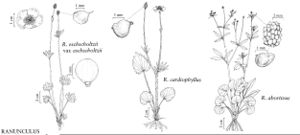Difference between revisions of "Ranunculus abortivus"
Sp. Pl. 1: 551. 1753.
imported>Volume Importer |
GeoffLevin (talk | contribs) m (Fixed Nfld. and Labr. distribution to match map in printed version.) |
||
| Line 48: | Line 48: | ||
|habitat=Woods, meadows, fallow fields, and clearings | |habitat=Woods, meadows, fallow fields, and clearings | ||
|elevation=0-3100 m | |elevation=0-3100 m | ||
| − | |distribution=St. Pierre and Miquelon;Alta.;B.C.;Man.;N.B.;Nfld. and Labr. | + | |distribution=St. Pierre and Miquelon;Alta.;B.C.;Man.;N.B.;Nfld. and Labr.;N.W.T.;N.S.;Ont.;P.E.I.;Que.;Sask.;Yukon;Ala.;Alaska;Ark.;Colo.;Conn.;Del.;D.C.;Fla.;Ga.;Idaho;Ill.;Ind.;Iowa;Kans.;Ky.;La.;Maine;Md.;Mass.;Mich.;Minn.;Miss.;Mo.;Mont.;Nebr.;N.H.;N.J.;N.Mex.;N.Y.;N.C.;N.Dak.;Ohio;Okla.;Pa.;R.I.;S.C.;S.Dak.;Tenn.;Tex.;Vt.;Va.;Wash.;W.Va.;Wis.;Wyo. |
|discussion=<p>Three varieties of <i>Ranunculus abortivus</i> are sometimes recognized. Plants from New England and the northern Appalachians often have thick stems and orbiculate leaves with narrow, deep basal sinuses; this form has been called <i>R. abortivus</i> var. eucyclus. Plants from southeastern Virginia may have the upper bracts merely lobed rather than deeply divided as is usual in <i>R. </i>sect.<i> Epirotes</i>; those have been called R. arbortivus var. indivisus.</p><!-- | |discussion=<p>Three varieties of <i>Ranunculus abortivus</i> are sometimes recognized. Plants from New England and the northern Appalachians often have thick stems and orbiculate leaves with narrow, deep basal sinuses; this form has been called <i>R. abortivus</i> var. eucyclus. Plants from southeastern Virginia may have the upper bracts merely lobed rather than deeply divided as is usual in <i>R. </i>sect.<i> Epirotes</i>; those have been called R. arbortivus var. indivisus.</p><!-- | ||
--><p>Native American tribes have used <i>Ranunculus abortivus</i> medicinally for a variety of purposes (D. E. Moerman 1986).</p> | --><p>Native American tribes have used <i>Ranunculus abortivus</i> medicinally for a variety of purposes (D. E. Moerman 1986).</p> | ||
| Line 68: | Line 68: | ||
|habitat=Woods, meadows, fallow fields, and clearings | |habitat=Woods, meadows, fallow fields, and clearings | ||
|elevation=0-3100 m | |elevation=0-3100 m | ||
| − | |distribution=St. Pierre and Miquelon;Alta.;B.C.;Man.;N.B.;Nfld. and Labr. | + | |distribution=St. Pierre and Miquelon;Alta.;B.C.;Man.;N.B.;Nfld. and Labr.;N.W.T.;N.S.;Ont.;P.E.I.;Que.;Sask.;Yukon;Ala.;Alaska;Ark.;Colo.;Conn.;Del.;D.C.;Fla.;Ga.;Idaho;Ill.;Ind.;Iowa;Kans.;Ky.;La.;Maine;Md.;Mass.;Mich.;Minn.;Miss.;Mo.;Mont.;Nebr.;N.H.;N.J.;N.Mex.;N.Y.;N.C.;N.Dak.;Ohio;Okla.;Pa.;R.I.;S.C.;S.Dak.;Tenn.;Tex.;Vt.;Va.;Wash.;W.Va.;Wis.;Wyo. |
|reference=None | |reference=None | ||
|publication title=Sp. Pl. | |publication title=Sp. Pl. | ||
Latest revision as of 16:06, 29 February 2024
Stems erect or nearly erect, 10-60 cm, glabrous, each with 3-50 flowers. Roots filiform, sometimes enlarged basally, 0.5-1.5 mm thick. Basal leaves persistent, blades reniform or orbiculate, undivided or sometimes innermost 3-parted or -foliate, 1.4-4.2 × 2-5.2 cm, base shallowly to deeply cordate, margins crenulate to crenate-lobulate, apex rounded to rounded-obtuse. Flowers: pedicels glabrous or nearly so; receptacle sparsely to very sparsely pilose; sepals 2.5-4 × 1-2 mm, abaxially glabrous; petals 5, 1.5-3.5 × 1-2 mm; nectary scale glabrous. Heads of achenes ovoid, 3-6 × 2.5-5 mm; achenes 1.4-1.6 × 1-1.5 mm, glabrous; beak subulate, curved, 0.1-0.2 mm. 2n = 16.
Phenology: Flowering late winter–summer (Mar–Jul).
Habitat: Woods, meadows, fallow fields, and clearings
Elevation: 0-3100 m
Distribution

St. Pierre and Miquelon, Alta., B.C., Man., N.B., Nfld. and Labr., N.W.T., N.S., Ont., P.E.I., Que., Sask., Yukon, Ala., Alaska, Ark., Colo., Conn., Del., D.C., Fla., Ga., Idaho, Ill., Ind., Iowa, Kans., Ky., La., Maine, Md., Mass., Mich., Minn., Miss., Mo., Mont., Nebr., N.H., N.J., N.Mex., N.Y., N.C., N.Dak., Ohio, Okla., Pa., R.I., S.C., S.Dak., Tenn., Tex., Vt., Va., Wash., W.Va., Wis., Wyo.
Discussion
Three varieties of Ranunculus abortivus are sometimes recognized. Plants from New England and the northern Appalachians often have thick stems and orbiculate leaves with narrow, deep basal sinuses; this form has been called R. abortivus var. eucyclus. Plants from southeastern Virginia may have the upper bracts merely lobed rather than deeply divided as is usual in R. sect. Epirotes; those have been called R. arbortivus var. indivisus.
Native American tribes have used Ranunculus abortivus medicinally for a variety of purposes (D. E. Moerman 1986).
Selected References
None.
